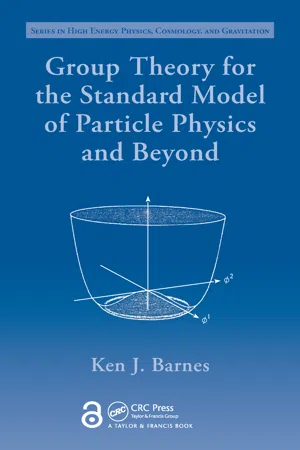
Group Theory for the Standard Model of Particle Physics and Beyond
Ken J. Barnes
- 255 pagine
- English
- PDF
- Disponibile su iOS e Android
Group Theory for the Standard Model of Particle Physics and Beyond
Ken J. Barnes
Informazioni sul libro
Based on the author's well-established courses, Group Theory for the Standard Model of Particle Physics and Beyond explores the use of symmetries through descriptions of the techniques of Lie groups and Lie algebras. The text develops the models, theoretical framework, and mathematical tools to understand these symmetries.
After linking symmetries with conservation laws, the book works through the mathematics of angular momentum and extends operators and functions of classical mechanics to quantum mechanics. It then covers the mathematical framework for special relativity and the internal symmetries of the standard model of elementary particle physics. In the chapter on Noether's theorem, the author explains how Lagrangian formalism provides a natural framework for the quantum mechanical interpretation of symmetry principles. He then examines electromagnetic, weak, and strong interactions; spontaneous symmetry breaking; the elusive Higgs boson; and supersymmetry. He also introduces new techniques based on extending space–time into dimensions described by anticommuting coordinates.
Designed for graduate and advanced undergraduate students in physics, this text provides succinct yet complete coverage of the group theory of the symmetries of the standard model of elementary particle physics. It will help students understand current knowledge about the standard model as well as the physics that potentially lies beyond the standard model.
Domande frequenti
Informazioni
Indice dei contenuti
- Cover
- Half Title
- Title Page
- Copyright Page
- Table of Contents
- Preface
- Acknowledgments
- Introduction
- 1 Symmetries and Conservation Laws
- 2 Quantum Angular Momentum
- 3 Tensors and Tensor Operators
- 4 Special Relativity and the Physical Particle States
- 5 The Internal Symmetries
- 6 Lie Group Techniques for the Standard Model Lie Groups
- 7 Noether’s Theorem and Gauge Theories of the First and Second Kinds
- 8 Basic Couplings of the Electromagnetic, Weak, and Strong Interactions
- 9 Spontaneous Symmetry Breaking and the Unification of the Electromagnetic and Weak Forces
- 10 The Goldstone Theorem and the Consequent Emergence of Nonlinearly Transforming Massless Goldstone Bosons
- 11 The Higgs Mechanism and the Emergence of Mass from Spontaneously Broken Symmetries
- 12 Lie Group Techniques for beyond the Standard Model Lie Groups
- 13 The Simple Sphere
- 14 Beyond the Standard Model
- Index